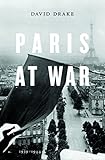Paris at war, 1939-1944 /David Drake.
Material type: TextPublication details: Cambridge, Massachusetts : The Belknap Press of Harvard University Press, (c)2015.Description: 1 online resource (viii, 545 pages, 26 unnumbered pages of plates) : illustrations, mapsContent type:
TextPublication details: Cambridge, Massachusetts : The Belknap Press of Harvard University Press, (c)2015.Description: 1 online resource (viii, 545 pages, 26 unnumbered pages of plates) : illustrations, mapsContent type: - text
- computer
- online resource
- 9780674495890
- D762 .P375 2015
- COPYRIGHT NOT covered - Click this link to request copyright permission: https://lib.ciu.edu/copyright-request-form
| Item type | Current library | Collection | Call number | URL | Status | Date due | Barcode | |
|---|---|---|---|---|---|---|---|---|
 Online Book (LOGIN USING YOUR MY CIU LOGIN AND PASSWORD)
Online Book (LOGIN USING YOUR MY CIU LOGIN AND PASSWORD)
|
G. Allen Fleece Library ONLINE | Non-fiction | D762.3 (Browse shelf(Opens below)) | Link to resource | Available | ocn933834938 |
Includes bibliographies and index.
Introduction: the road to war, September 1938-September 1939 -- The phoney war, 3 September 1939-10 May 1940 -- Blitzkrieg and exodus, 10 May 1940-14 June 1940 -- Parisians and Germans, Germans and Parisians -- Paris, German capital of France -- Unemployment, rationing, Vichy against Jews, Montoire -- From mass street protest to the "fuhrer's generous gesture" -- Protests, pillaging, "v" for victory, the first roundup of Jews -- Resistance and repression -- Resistance, punishment, allied bombs, and deportation -- SS seizure of security, the yellow star, the vel'd'hiv' roundup, la releve -- Denunciations, distractions, deprivations -- Labour conscription, resistance, the French gestapo -- Anti-Bolshevism, black market, more bombs, Drancy -- A serial killer on the run, Petain in Paris, the milice on the rampage, the allies on their way -- The liberation of Paris -- Conclusion.
Chronicles the lives of ordinary Parisians during World War II, from September 1939 when France went to war with Nazi Germany to liberation in August 1944. Relive the fearful exodus from the city as the German army neared the capital, the relief and disgust felt when the armistice was signed, and the hardships and deprivations under Occupation.
"Paris at War chronicles the lives of ordinary Parisians during World War II, from September 1939 when France went to war with Nazi Germany to liberation in August 1944. Readers will relive the fearful exodus from the city as the German army neared the capital, the relief and disgust felt when the armistice was signed, and the hardships and deprivations under Occupation. David Drake contrasts the plight of working-class Parisians with the comparative comfort of the rich, exposes the activities of collaborationists, and traces the growth of the Resistance from producing leaflets to gunning down German soldiers. He details the intrigues and brutality of the occupying forces, and life in the notorious transit camp at nearby Drancy, along with three other less well known Jewish work camps within the city. The book gains its vitality from the diaries and reminiscences of people who endured these tumultuous years. Drake's cast of characters comes from all walks of life and represents a diversity of political views and social attitudes. We hear from a retired schoolteacher, a celebrated economist, a Catholic teenager who wears a yellow star in solidarity with Parisian Jews, as well as Resistance fighters, collaborators, and many other witnesses. Drake enriches his account with details from police records, newspapers, radio broadcasts, and newsreels. From his chronology emerge the broad rhythms and shifting moods of the city. Above all, he explores the contingent lives of the people of Paris, who, unlike us, could not know how the story would end."--Publisher's description.
COPYRIGHT NOT covered - Click this link to request copyright permission:
There are no comments on this title.
